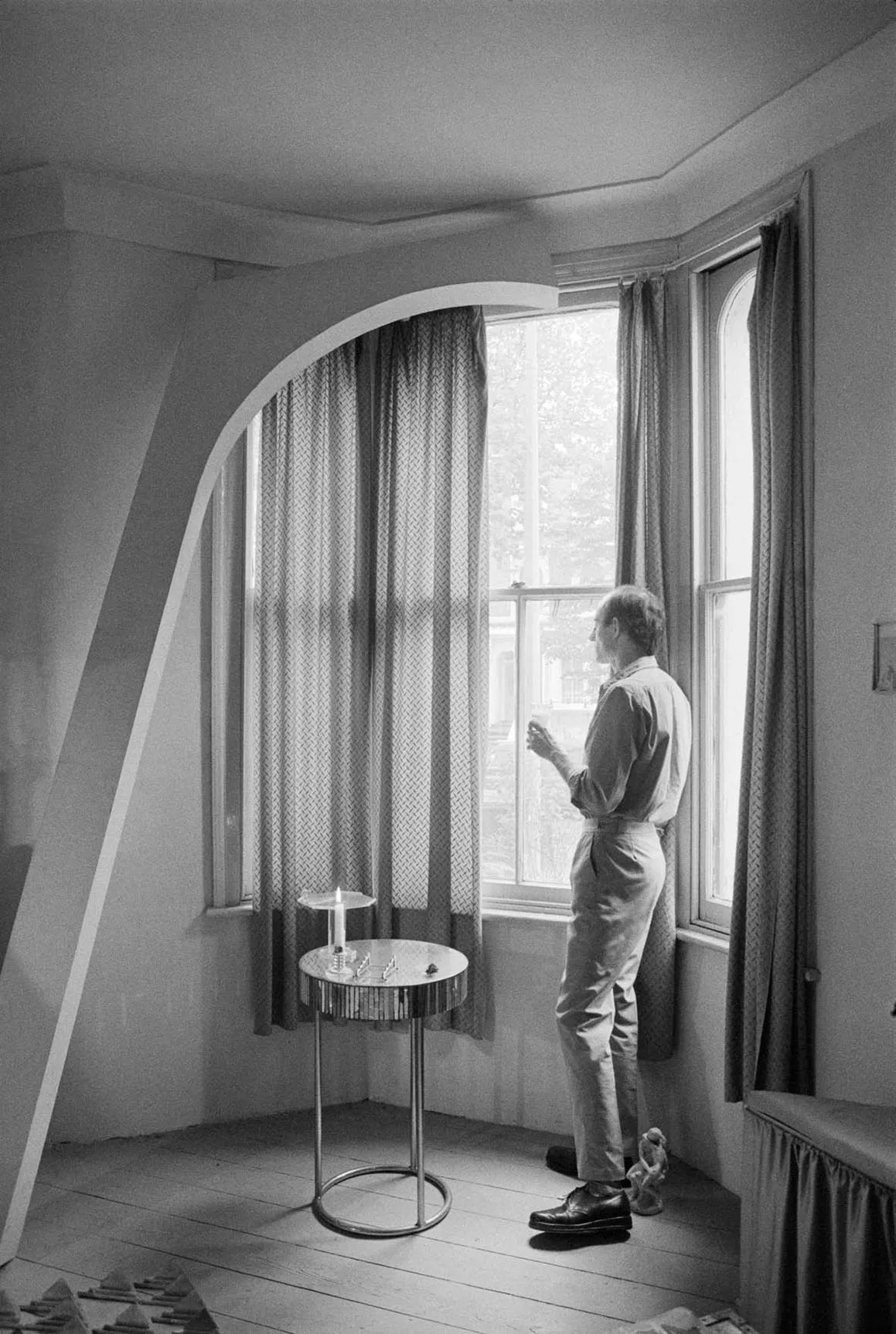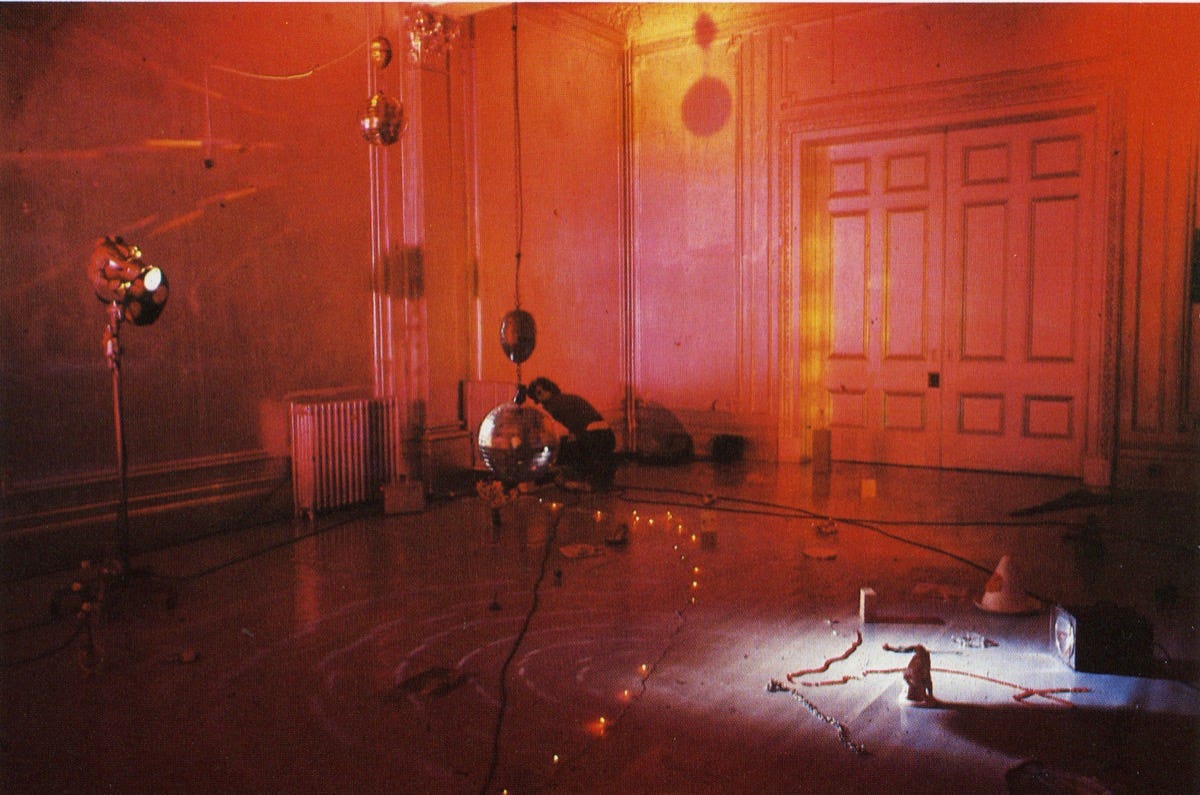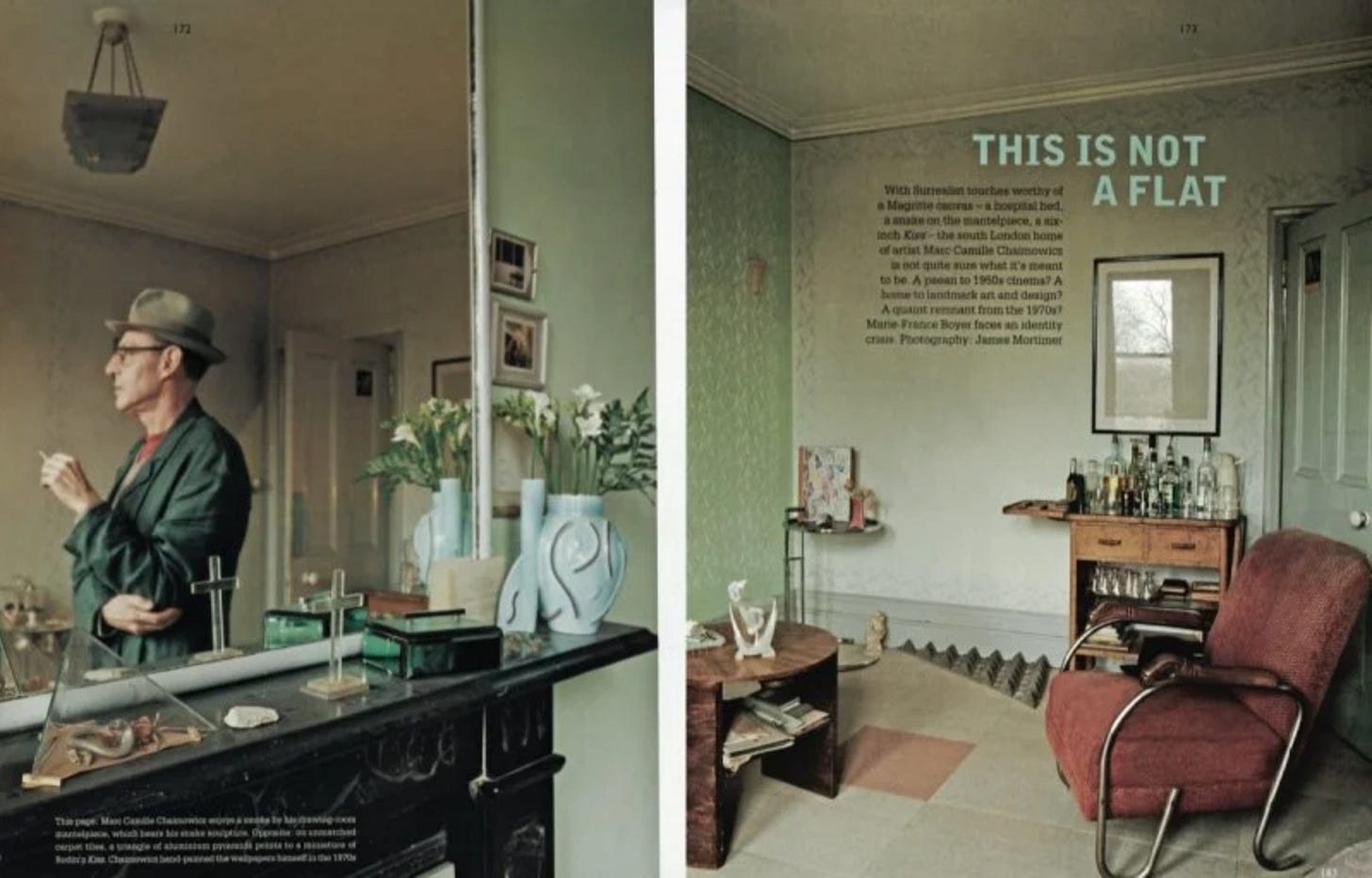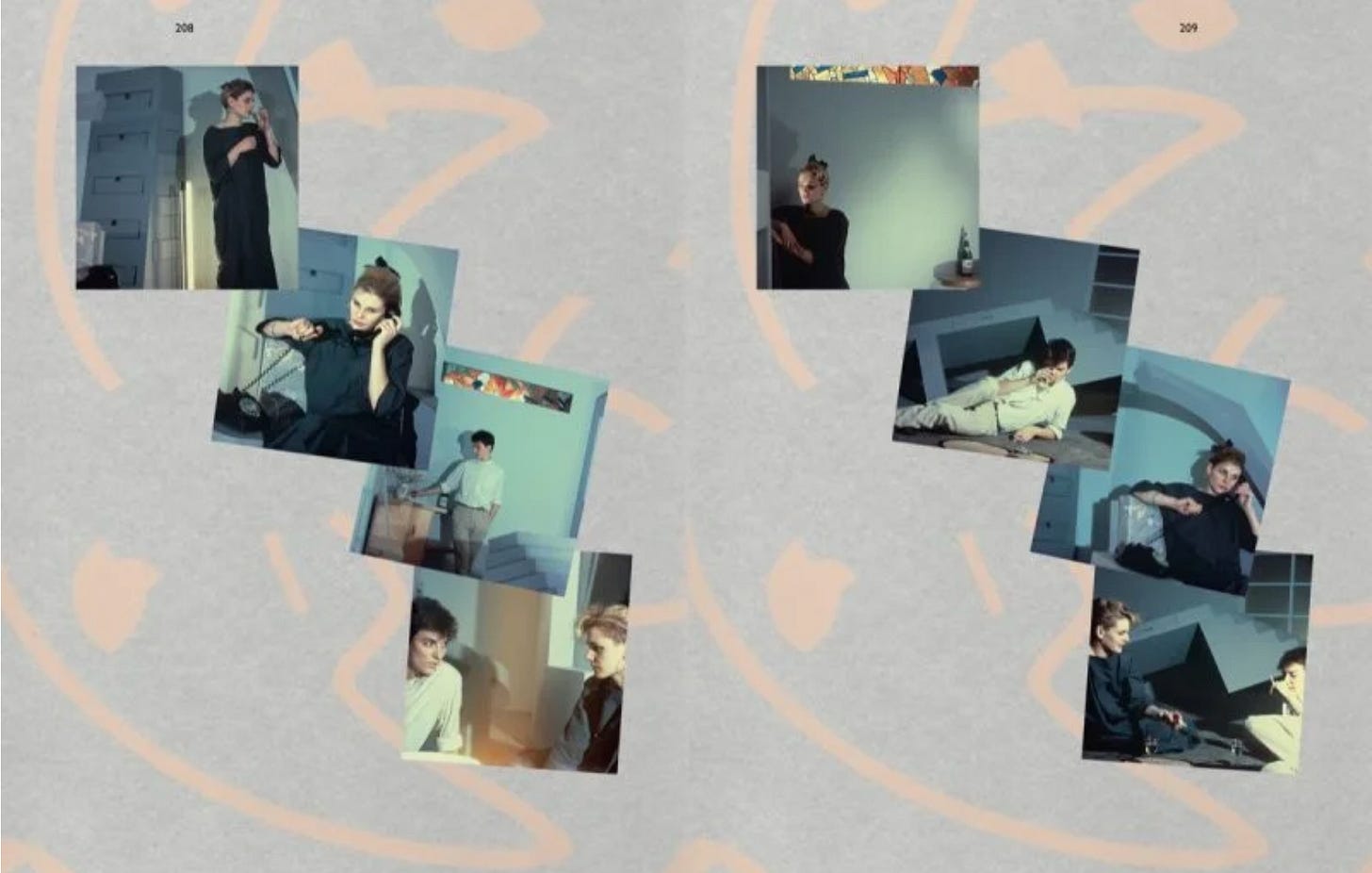Marc Camille Chaimowicz loved ellipses. The artist, who passed away in May, used them liberally in his correspondences. Ellipses ornamented his artwork titles and gave rhythm to his published writing. He would never have put his name to anything as declarative as an artistic manifesto—such things are too pleased with being right, skirt too close to the petrified mindset of ideology—but if he did it would have been simply … A modest ellipsis, a tool for evoking ambiguity … privacy … space … a quiet eroticism. A mark which privileges allusion over assertion. It allows for the possibility that someone or something new may enter the picture. If Marc Camille were to give those three dots a colour, they would not be in childish primaries but in his preferred pastels or greys: “greys that seem to tap a reservoir of nuance and colour,” he once wrote, “… in a sense, not really greys at all … greys that in their handling have become more than a mix of two extremes … have become a new breed.”
I met Marc Camille when I was a student at the Ruskin School of Fine Art in Oxford during the mid-1990s. He came up from London to give tutorials a couple of times each term and had, by then, perfected his uniform: a trilby or cap, a shirt and blazer accented with an elegant silk scarf. Marc Camille took young people seriously. We’d talk in my little studio space, he would sit and roll a cigarette, ask how I was doing, how the work was coming along. Charming and funny, he was generous with suggestions, courteous without making a meal of performing good manners. This was, in subtle ways, a key part of his work. Many artists are good at seeing, fewer are good at listening. He knew how to put others at the centre of conversation. If his art was the subject of discussion, he would treat you as his equal, make you feel as if you had an important part to play in articulating his ideas. As news of his death circulated, variations on the same remark recurred: “he was a real gent.”
We tend to fix people in our minds at the age they are when we first meet them, but I was never quite sure what age he was. I noticed how he would sometimes omit his birth year from exhibition biographies, replacing it with “born in postwar Paris.” It is strange for me to realize now that when I was a student, he was only a couple of years older than I am today. There was always something out-of-time about Marc Camille and his work, simultaneously old world and ultra modern, possessed of qualities, “stored in the future to be exhumed in the past,” to borrow a line from Michael Bracewell’s Souvenir. His careful diction and syntax carried distant echoes of an other era, while his energy and excitement was for the new—or new ways of revisiting old work. He spoke about feeling out-of-place, suspended in-between—those ellipses again—something he put down to his Anglo-French identity, to the wrench of moving as a child in the early 1950s from Paris to the English new town of Stevenage. (In his adult years he lived between London and Dijon.) As he once put it to me, “if somebody in his early childhood is removed from a particular cultural environment and then has to process that relatively brutal displacement, that person is liable, is he not, to fantasize?”
Through his art—literary, romantic, epistolary, equal parts sensual and intellectual—Marc Camille could dream of his artist forebears in interwar Paris or Vienna. Working relationships with other artists kept him grounded in present-day London. He drew and painted semi-abstract forms—hints of flowers and feathers whispering from lines of fluent brushwork and stippled marks, neatly-inked Art Deco geometries. These functioned as drawings and paintings but could also be used as designs for fabric and wallpaper. He made sculptures which doubled as desks and chairs, chairs that could be flipped into chaise-longues, upholstered in patterns derived from drawing. The substance of his work, however, lay in the question of how we use such things to shape our private and social selves.
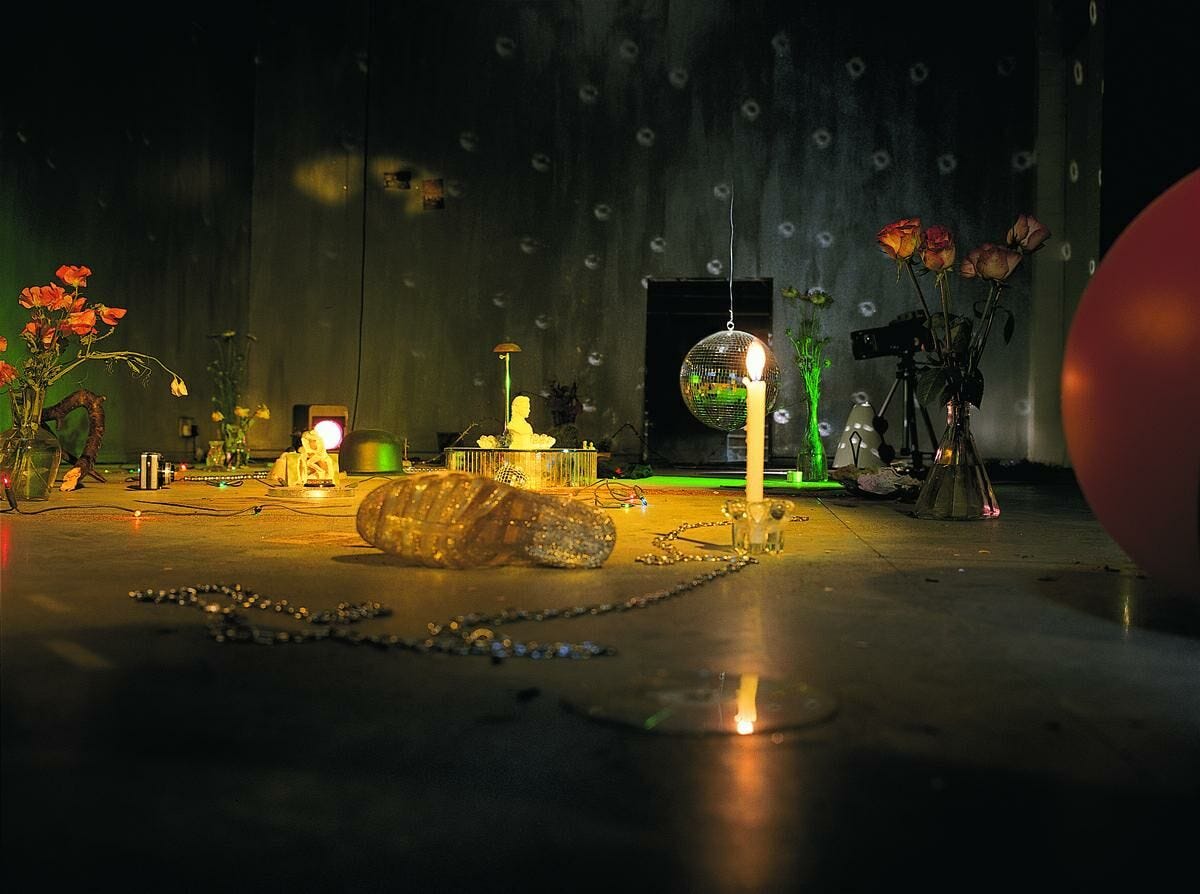
For Celebration? Reallife, a significant early piece made in 1972 for the inaugural show at Gallery House, London, Marc Camille dressed the floor with archipelagos of beads and mirrors, flowers, candles, plastic tat and copies of the International Times. There was a bust of Beethoven, a photo of Lenin, another of Janis Joplin. Coloured light spilled across the floor. Glitterballs ricocheted the colours around the gallery. It looked like the aftermath of a party. It was excessive, intoxicating. Marc Camille, in jelly sandals, offered visitors coffee and conversation, played records for them by David Bowie and The Who. He tended to the space as if it were housework. This was decades before a certain type of participatory art came into fashion, before scattering objects across the floor became a familiar device in sculpture. (Squinting hard enough, it may have been possible to trace the influence of Allan Kaprow’s Happenings in the piece, and perceive in the work a kind of Situationism for those who distrusted -isms.) Gustav Metzger, who was exhibiting a conceptual work on the floor above Marc Camille, remembered the air, heavy with odours and heat from the lamps. Barricaded into the space downstairs lurked the artist Stuart Brisley, who was painting the derelict rooms black. The exhibition was titled ‘Three Life Situations.’ Martin McGeown, co-founder of Cabinet Gallery, who represented Marc Camille’s work, once described to me that vertical stack of Brisley, Chaimowicz and Metzger at Gallery House as, respectively, the id, ego and superego of British art that year.
Gaston Bachelard, Jean Cocteau, Jean Genet, and Marcel Proust were Marc Camille’s touchstones. “I’m working more closely to the way writers might,” he told me, “in that they establish certain parameters of sensibility and then elaborate new work to look at different aspects of their central concern.” His work synthesized painting, performance, writing, sculpture, ceramics, and interior design. Combinations of each element were kept perpetually open-ended: a photograph might appear in a sequence of slides for a performance piece, then a year later turn up in a book, and decades on, hung on the wall. This sense of recurrence imitated the way an old memory can surface then dissolve into a new context. He would invite artists to contribute pieces for his room installations, put them alongside works by early 20th century modernists, and offer his own work for others to use. Rugs, folding screens, and movable panels could be rearranged as if to satisfy a change of mood or circumstance. Repeat patterns, such as those used for wallpaper or endpapers in books, suggested a species of idea which could extend beyond the edges of its support, design with an infinite horizon. His work appeared on advertisements, on commercially produced scarves, textiles, wine labels. He delighted in the idea of producing a wallpaper or fabric anonymously, to be mass-produced and sold under the name of its supplier, so that someone might pick out a design for their home purely for the way it looked rather than who made it.
In the 1970s, as Marc Camille’s work began to find its shape and move away from the scatter style of Celebration? Reallife and its sister piece, Enough Tiranny [sic], the applied arts and their expression in the domestic environment became profoundly important to him. He made images of himself at home, doing household tasks, hosting a visitor, or lost in reverie. Marc Camille was attuned to the pop culture of the period: glam rock androgyny, Patti Smith and Lou Reed, the sophisticated art-into-life style games of those Peter York referred to as “Thems.” (By the early 1980s, his evocations of old modernist European sensibilities, sung to the tune of American-influenced pop, would be read as New Romantic.) But Marc Camille’s interest in the applied arts ran against the grain of the macho formalism, didactic politics and dry “critique” which then dominated the art world. Design for the home was regarded as feminine, inferior to heroic painting and sculpture. Colour was suspect. Pleasure was reactionary. I recall him telling me how much he disliked the use of the word ‘rigour’ in art—the way people said they admired “formal rigour,” or used “conceptually rigorous’ as a compliment—describing it as “tyrannical,” an intellectual machismo, a boast of power which left nothing to the imagination or to doubt.
Gradually, Marc Camille was integrating design and art into every aspect of his life, out of a typically understated and quiet refusal to be categorized. To understand what he was doing, wrote Stuart Morgan: “Unlearn “art”. Unlearn “artwork”. Unlearn “closure”. Unlearn “public” and “private”. Finally unlearn “man”. Decoration, the use of cosmetics, most of all an insistence on abandoning machismo as a mode of artistic behaviour, have served to make his desire for universality even more evident.”
It was common then for artists to use their studios as the setting for photos and videos. But where industrial lofts in New York’s SoHo or the disused Victorian warehouses on Bankside in London could double as white cube galleries in the rough, Marc Camille’s studio, a terraced house on Approach Road in east London, resembled a conventional home. “The lease was short term and soon he would have to move,” read the text for his 1977 book Dream, an anecdote, “but he had decorated it to his taste and attempted to keep it tidy, to wash the windows regularly, to water the plants, to house clean … Here he could sit alone for hours, day dreaming and wandering, dwelling on ills and pleasures and on how personalities were affected by inner and outer worlds…”
At Approach Road he shot intimate black-and-white images of people sharing coffee and cigarettes, faces out of frame or turned with diffidence away from the camera. He photographed chairs arranged around a side table. The artist asleep in bed, or looking out of a bay window onto the street, or stood in the hallway calling a friend on the a phone. The figure in the image was usually Marc Camille, occasionally a woman with short hair, dressed in similar clothes. In the background, you might spot one of his designs hand-stencilled onto the wall. At the edge of the image, a sculpture, subordinated to curtains and a vase of flowers, working to balance the elements in the composition. He paired his images with writing. Travelogues, meditations, third-person narratives about an unnamed person who may or may not be Marc Camille. It was impossible to know which came first, whether the words followed the image, or vice versa. The mystery was important; the sense of simultaneity between language and image imitated thought.

Occasionally he would make a more intensely romantic image: in Table Tableau, for instance, he is slumped forward on a dresser, half-naked, make-up on his face, a glass of Pernod at his elbow, a fox fur at his feet. The set-up was based on a story he knew about a man sat alone one night in the Lyons Corner House, Marble Arch, during the 1930s. The man heard a piece of music so moving that he got up and left to fight in the Spanish Civil War. Table Tableau existed as a gallery performance. It appeared as a tightly-cropped photograph shot in his home, reproduced on the cover of Studio International. Marc Camille also reworked it as a short video to be shown on television, accompanied by a violin composition by Conal Shields. Each time it was a little different in colour and composition, as if to escape being definitive. There was always the sense in Marc Camille’s work, as there is when trying to get to know any person, that you were only ever getting a partial view of something bigger that was out of frame, and that there was an important element of his art being kept private from the world.
This was not statement art, not a conceptual puzzle to be solved. His images were irreducible and enigmatic. They were scents and suggestions. Today these qualities seem ever more valuable amid the bossy clamour of “aboutism”; of this artwork being “about” that issue, of this “dealing with” that. The violence of certainty. Rigour. For Marc Camille, domestic tasks, enjoying company, making art, were all variables which could be tuned in and out of visibility, in and out of being art or being simply what they were—doing the dishes, dinner with a friend.
From Approach Road he had moved to a flat in south London. Visitors to his home would arrive to find chairs arranged around a small table in the living room, on which would be set porcelain cups and a pot of coffee. The curtains were drawn just-so, to calibrate the atmosphere, letting in enough light to bring out dustings of peppermint colour on the wall and taupe in the carpeting. The situation was in search of an elusive temperance of mood. What was remarkable was how it could feel so informal while simultaneously subtly choreographed. A visitor might, at some point during the conversation, spot an object familiar from one of Marc Camille’s books. They may then feel as if they were in a photo they remembered from in a museum somewhere, pinned to a folding screen, projected in a darkened room. It didn’t need explanation. This was private conviviality and a private act of art, which didn’t need to be proven in public or explained online. A scene in a Gesamtkunstwerk that didn’t need to show-off about being one. But creative industries do not always understand creative individuals. In 2008, The World of Interiors magazine ran a feature about the flat. Marc Camille took the entire issue and turned it into an exquisitely made artist’s book, also titled The World of Interiors, complete with the advertisements and other articles, cut up, collaged, shuffled, recontextualized, drawn and stencilled over, new and old texts added. Condé Nast, owners of the magazine, missed the point and demanded that all copies of the book were to be confiscated and pulped.
When I was a student, I had the (possibly mistaken) impression that Marc Camille’s work had disappeared from view in the UK. It was illegible to whichever version of the 1990s each of the various factions of the British art world was experiencing. Too private and romantic for the brash one sprawled over the tabloids and on the pavement outside Soho drinking clubs; too ambiguous and small-‘p’ political for the if-it-hurts-it’s-good-for-you theory boys and armchair revolutionaries; still too light for the heavy metal sculptors in their big dusty work boots. But the lunar cycles turned and in the early 2000s Marc Camille’s work reemerged as if returning from a quiet retreat. People were excited about performance art again. The relationship between art and design was under discussion. Old back issues of Studio International from the 1970s were being dusted off in order to remember what had been forgotten.
I didn’t see Marc Camille for some years after college. By that time I was working as an editor at frieze magazine. His gallery, I seem to recall, had put us back in touch, for an article I was writing about his work. I travelled to Berlin to see him revive a performance from 1980 titled Partial Eclipse, which he staged again soon after at Tate Britain. A dissolving slideshow of views inside Approach Road. A sense of pale winter light. A female voice evokes interior feelings, describes a meeting. Marc Camille paces the room, interrupting the projector beam and images of his younger self. Kraftwerk then Eno in the background. Curling cigarette smoke. Dust motes. Solitude. The dot-dot-dot. (Curator Catherine Wood, a friend and supporter of the artist for decades, remembers that she had to obtain special permission to allow Marc Camille to smoke inside the Tate galleries for the performance.) Soon after my essay was published, I received a package in the post. Inside was an inscribed copy of Marc Camille’s 1985 book Café du rêve, along with a letter.
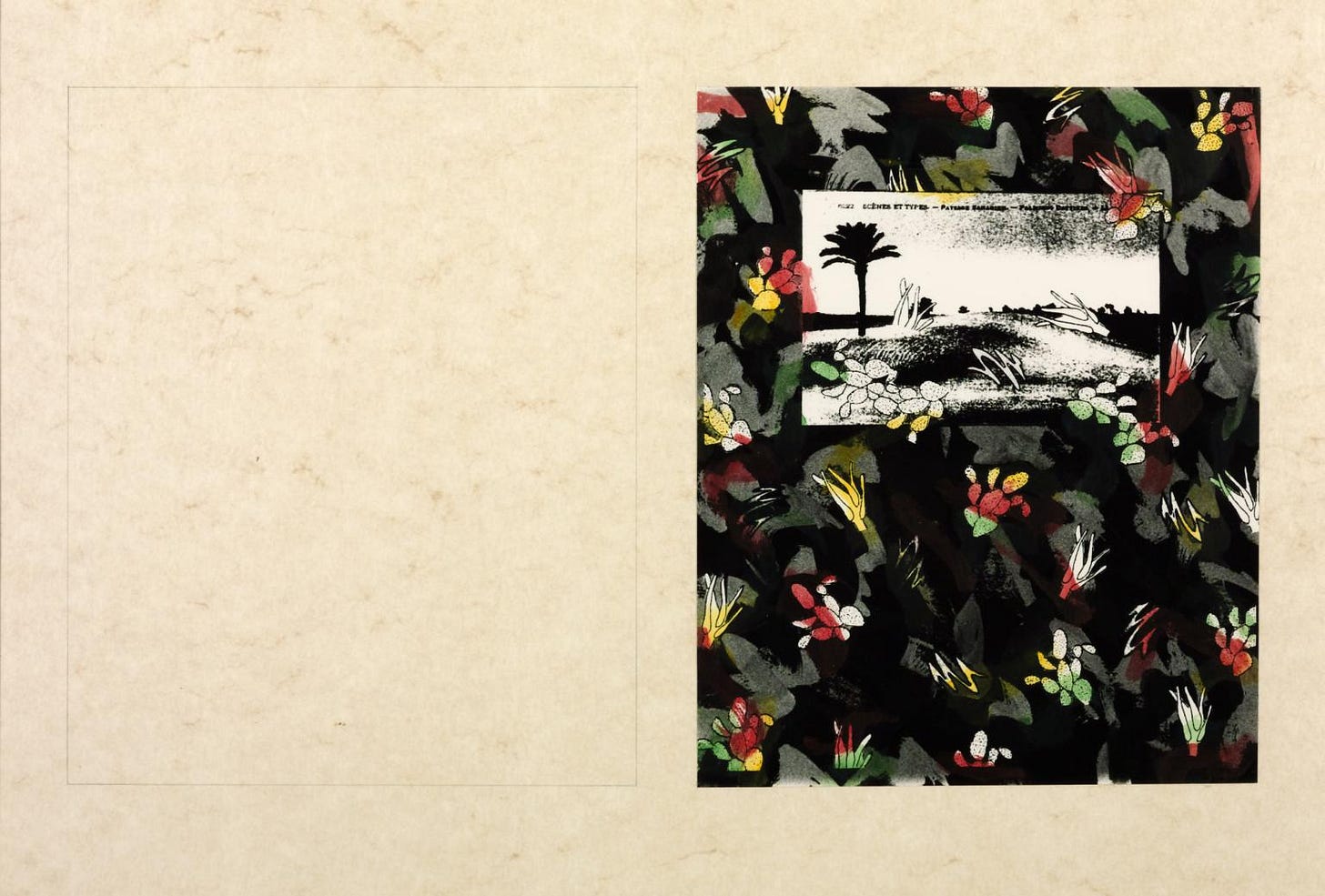
Café du rêve is an illustrated travelogue in which an unnamed narrator describes a journey through Europe and north Africa. It is diaristic and reflective, punctuated by occasional ecstatic details about each place. Postcards and photographs of empty squares, parks and doorways attempt to capture emotional events invisible to the camera. These are set against hand-drawn decorative backgrounds and type arranged like blank verse. The letter which came in the package was handwritten. In short, evocative sentences, Marc Camille described receiving the magazine through the mail and looking at the layout of the feature. He wrote that his first impressions felt good, but that he wanted to take a walk before reading it. The letter described the weather and the quiet mood of London in late December, empty of people disappeared home for the holidays. Returning to his flat he wrote that he decided—I can recall the phrases exactly—“to pour myself a glass of green chartreuse” and “retreat to the bedroom,” to read the article. There followed a paragraph about my essay. He signed off the letter “with empathy.”
Private correspondences such as these matter to writers more than anything public. Without the sense that the art has been seen and the words have been read, for artists and writers alike, we might as well be talking to ourselves. Marc Camille was always encouraging to young artists, curators and writers. For a 2008 show at De Appel he chose the title ‘… In the Cherished Company of Others …’ He explained to me how this “hopefully implies that, although we might choose to court solitude to a high degree, we should never find ourselves fetishizing the sadness of isolation, conceptual or otherwise.” The recognition that no artist—nobody—can function in sequestration from the world was baked into his work. One recurring motif was a sculpture in the form of a half-arch, which leans on the wall rather than supports anything. It can be spotted in some of his Approach Road photographs, propped against a bay window frame. In one sense, this thing is asking for company—it needs another pillar in order to stand upright. Yet there is a subtle truth in this half-complete shape. It is an object which is whole in its desire to be whole. None of us can ever be completed, or entirely “understood” by another person. The half-arch stands for both solitude and for sociability.
Our conversations continued. I wrote about his work for a small catalogue published by a German museum. We did a talk together for students at the Royal Academy Schools in London, at the invitation of the artist Kira Freije, part of another, younger, generation he’d come into contact with. He invited me to write the music for a short video he had made based on Genet’s play, The Maids. One of his Approach Road photographs was reproduced in my book Pretentiousness: Why It Matters, and he was amused when it appeared on the cover of the Spanish translation, Pretenciosidad. During Covid we emailed about walking in the parks we each lived next to—his in London, mine in New York—and Marc Camille was, as ever, excited to make his next exhibition and book. I felt seen by him, and understood as a creative person who was more than his day job. The important point is that I was far from unique in this: countless others who knew Marc Camille have stories of his friendship and support which go much deeper than mine.
I’ve never forgotten that letter he sent some twenty years ago. It seems typically Chaimowiczian that a light gesture could carry great weight. Since then I’ve tried, not always successfully, to keep his sign-off in mind as a working motto: “with empathy.” Stuart Morgan—coincidentally another regular at the Ruskin School in the 1990s—wrote that “photography, as Chaimowicz himself remarks in a footnote to Café du rêve, is unable to record certain sensations which seem eminently photographable. Nor can feelings be captured which are apparently very precise. The danger is of restoring the picture badly—of describing a man in a room, rather than a certain man in a special room.” Like a camera I now find that my pictures of Marc Camille cannot describe a certain man in a special room.

